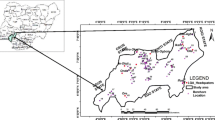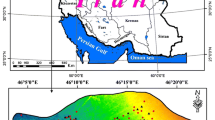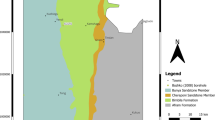Abstract
A prediction at a regional scale of groundwater productivity potential mapping in an area is subjected to uncertainties that must be efficiently managed for enhancing decision making. This study explored the potential of a GIS-based Dempster–Shafer theory (DST) model as a spatial prediction model to offer solution to this problem. Seven criteria/factors regarded as positive indicators to the existence of promising groundwater reservoir in a given study area were selected and weighted in a probability-based DST approach to compute degrees of belief functions component indexes. The results of the computed belief function indexes values were processed in GIS environment to generate belief functions maps among which the uncertainty index map established uncertainty result of relatively low range of <1 to 9 % prediction in the area. The belief index map which provides concrete support for the existence of promising aquifers in the area was modeled to produce the groundwater potential zones prediction (GPZP) map. A developed mathematical model based on the relationship between the estimated Belief index values and borehole yield data established the influences of diverse rock type’s properties on the aquifer productivity in the area. The effect of coherence of criteria on the efficiency of DST model as a prediction model was also examined. The GPZP map produced was found to be 85.71 % accurate. The results of the examination of the effect of coherence of the criteria revealed that the ability of the DST model to produce accurate prediction is dependent on the exhaustiveness of the set of criteria used. The obtained results illustrate the usefulness of knowledge-driven DST model in GIS-based predictive mapping of groundwater potential zones. The results also show the capability of DST model in managing uncertainty associated with the predictive potential zones in the study area.










Similar content being viewed by others
References
Adiat KAN, Nawawi MNM, Abdullah K (2012) Assessing the accuracy of GIS-based elementary multi criteria decision analysis as a spatial prediction tool—a case of predicting potential zones of sustainable groundwater resources. J Hydrol 440:75–89. doi:10.1016/j.jhydrol.2012.03.028
Adiat KAN, Nawawi MNM, Abdullah K (2013) Application of multi-criteria decision analysis to geoelectric and geologic parameters for spatial prediction of groundwater resources potential and aquifer evaluation pure. Appl Geophys 170:453–471. doi:10.1007/s00024-012-0501-9
Al Saud M (2008) Using ASTER images to analyze geologic linear features in Wadi Aurnah basin, western Saudi Arabia. Open Remote Sens J 1:17–25, International Journal of Remote Sensing. Vol. 27, No. 20, 20 October 2006, 4599–4620
Al-Saud M (2010) Mapping potential areas for groundwater storage in Wadi Aurnah Basin, western Arabian Peninsula, using remote sensing and geographic information system techniques. Hydrogeol J 18:1481–1495. doi:10.1007/s10040-010-0598
Althuwaynee OF, Pradhan B, Lee S (2012) Application of an evidential belief function model in landslide susceptibility mapping. Comput Geosci 44:120–135. doi:10.1016/j.cageo.2012.03.003
Awasthi A, Satyaveer CS (2011) Using AHP and Dempster–Shafer theory for evaluating sustainable transport solutions. Environ Model Softw 26(6):787–796. doi:10.1016/j.envsoft.2010.11.010
Babiker IS, Mohamed AA, Mohamed TH (2007) Assessing groundwater quality using GIS. Water Resour Manag 21:699–715. doi:10.1007/s11269-006-9059-6
Carranza EJM, Hale M (2002) Evidential belief function for data-driven geologically constrained mapping of gold potential, Baguio district, Philippines. Ore Geol Rev 22:117–132
Carranza EJM, Woldai T, Chikambwe EM (2005) Application of data-driven evidential belief functions to prospectivity mapping for aquamarine-bearing pegmatites, Lundazi District, Zambia. Nat Resour Res 14(1):47–63. doi:10.1007/s11053-005-4678-9
Carranza EJM, Van Ruitenbeek FJA, Hecker C, Van Der Meijde M, Van der Meer FD (2008) Knowledge-guided data-driven evidential belief modeling of mineral prospectivity in Cabo de Gata, SE Spain. Int J Appl Earth Obs Geoinform 10(3):374–387
Chowdhury A, Jha MK, Chowdary VM, Mal BC (2009) Integrated remote sensing and GIS-based approach for assessing groundwater potential in West Medinipur district, West Bengal, India. Int J Remote Sens 30(1):231–250
Chung CF, Fabbri AG (1993) The representation of geosciences information for data integration. Nonrenew Resour 2:122–139
de Vries JJ, Simmers I (2002) Groundwater recharge: an overview of processes and challenges. Hydrogeol J 10:5–17. doi:10.1007/s10040-001-0171-7
Dempster AP (1967) Upper and lower probabilities induced by a multi-valued mapping. Ann Math Stat 38:325–339
Edet AE, Okereke CS (1996) Assessment of hydrogeological conditions in basement aquifers of the Precambrian Oban Massif, Southwestern Nigeria. J Appl Geophys 36:195–204
Edet AE, Okereke CS, Teme SC, Esu EO (1998) Application of remote-sensing data to groundwater exploration: a case study of the Cross River State, southeastern Nigeria. Hydrol J 6:394–404
Engman ET, Gurney RJ (1991) Remote sensing in hydrology. Chapman and Hall, London, 225 pp ENviron Geol 52:477–487
Ettazarizini S, El Mahmouhi N (2004) Vulnerability mapping of the Turonian limestone aquifer in the phosphate plateau (Morocco). Environ Geol 46:113–117. doi:10.1007/s00254-004-1022-3
European Commission (1995) Soil terrain database. Land Management and Natural Hazards Unit. IES and JRC, European Commission, Brussels. <http://eusoils.jrc.ec.europa.eu/projects/soter/soter_model.html> (accessed 30.03.11)
Ewusi A, Kuma JS, Voigt HJ (2009) Utility of the 2-D multi-electrode resistivity imaging technique in groundwater exploration in the Voltaian sedimentary basin, Northern Ghana. Nat Resour Res 18(4):267–275
Feizizadeh B, Blaschke T (2013) GIS-multicriteria decision analysis for landslide susceptibility mapping: comparing three methods for the Urmia lake basin, Iran. Nat Hazards 65:2105–2128. doi:10.1007/s11069-012-0463-3
George T, Pal NR (1996) Quantification of conflict in Dempster-Shafer framework: a new approach. Int J Gen Syst 24(4):407–423
Goodchild MF (1993) The state of GIS for environmental problem solving. In: Goodchild MF, Parks BO, Steyaert LT (eds) Environmental modeling with GIS. Oxford University Press, New York, pp 8–15
Greenbaum D (1989) Hydrogeological applications of remote sensing in areas of crystalline basement. Paper presented at the In: Proc Groundwater Exploration and Development in Crystalline Basement Aquifers, Zimbabwe
He B, Cui Y, Chen C, Chen J, Liu Y (2011) Uncertainty mapping method for mineral resources prospectivity integrating multi-source geology spatial data sets and evidence reasoning model. In: Geoinformatics, 2011 19th International Conference on (pp. 1–5). IEEE
Hoque MA, Khan AA, Shamsudduha M, Hossain MS, Islam T, Chowdhury SH (2009) Near surface lithology and spatial variation of arsenic in the shallow groundwater southeastern Bangladesh. Environ Geol 56:1687–1695. doi:10.1007/s00254-008-1267-3
Jha MK, Peiffer S (2006) Applications of remote sensing and GIS technologies in groundwater hydrology: past, present and future. BayCEER, Bayreuth, 201 pp
Jha MK, Chowdhury A, Chowdary VM, Peiffer S (2007) Groundwater management and development by integrated remote sensing and geographic information systems: prospects and constraints. Water Resour Manag 21(2):427–467
JMG (2007) Hydrogeological map of Selangor and Kuala Lumpur Federal Territory. Scale 1:250,000
Johnston K, Hoef JMV, Krivoruchko K, Lucas N (2003) Using ArcGIS Geostatistical Analyst, Printed in the United States of America
Keeney JM, Raiffa H (1976) Decisions with multiple objectives: preferences and value tradeoffs. Wiley, New York
Khairul A, Juhari MA, Ibrahim A (2000) Groundwater prediction potential zone in Langat basin using the integration of RS and GIS. Paper Presented at the Asian Conference of Remote Sensing (ACRS). Taipei, Taiwan (December 4–8, 2000)
Lee S, Kim YS, Oh HJ (2012a) Application of a weights-of-evidence method and GIS to regional groundwater productivity potential mapping. J Environ Manag 96(1):91–105. doi:10.1016/j.jenvman.2011.09.016
Lee S, Kyo-Young S, Kim Y, Park I (2012b) Regional groundwater productivity potential mapping using a geographic information system (GIS) based artificial neural network model. Hydrogeol J. doi:10.1007/s10040-012-0894-7
Lee S, Hwang J, Park I (2012c) Application of data-driven evidential belief functions landslide susceptibility mapping in Jinbu, Korea. CATENA 100:15–30
Likkason OK, Shemang EM, Suh CE (1997) The application of evidential belief function in the integration of regional geochemical and geological data over the Ife-Ilesha goldfield, Nigeria. J Afr Earth Sci 25(3):491–501. doi:10.1016/S0899-5362(97)00119-X
Machiwal D, Jha MK, Mal BC (2011) Assessment of groundwater potential in a semi-arid region of India using remote sensing, GIS and MCDM techniques. Water Resour Manag 25:1359–1386. doi:10.1007/s11269-010-9749-y
Madan KJ, Chowdary VM, Chowdhury A (2010) Groundwater assessment in Salboni Block, West Bengal (India) using remote sensing, geographical information system and multi-criteria decision analysis techniques. Hydrogeol J 18:1713–1728
Malaysia, Minerals and Geoscience Department (2004) Impact of the 26th December 2004 Tsunami on Groundwater Systems and Groundwater Based Water Supplies in Malaysia
Manap MA, Sulaiman WNA, Ramli MF, Pradhan B, Surip N (2011) A knowledge-driven GIS modeling technique for groundwater potential mapping at the Upper Langat Basin, Malaysia. Arab J Geosci:1–17
Mathon BR, Metin MO, Pinder GF (2010) Dempster-Shafer theory applied to uncertainty surrounding permeability. Math Geosci 42:293–307
Meijerink AMJ (2007) Remote sensing applications to groundwater IHP-VI, Series on Groundwater No. 16, UNESCO, Paris
Mogaji KA, Aboyeji OS, Omosuyi GO (2011) Mapping of lineaments for groundwater targeting in the basement complex region of Ondo State, Nigeria, using remote sensing and geographic information system (GIS) techniques. Int J Water Resour Eng 3(7):150–160
Mogaji KA, Lim HS, Abdullah K (2013) Modeling groundwater vulnerability prediction using geographic information system (GIS)-based ordered weighted average (OWA) method and DRASTIC model theory hybrid approach. Arab J Geosci:1–21
Mohamed SE, Juanah SI, Wan NAS, Puziah AL (2012) Groundwater resources assessment using integrated geophysical techniques in the southwestern region of Peninsular Malaysia. Arab J Geosci. doi:10.1007/s12517-012-0700-9
Moon WM (1990) Integration of geophysical and geological data using evidential belief function. IEEE Trans Geosci Remote Sens 28(4):711–720
Moon WM (1998) Integration and fussion of geological exploration data: a theoretical review of fuzzy logic approach. Geosci J 2(4):175–183
Moore TA, Al-Rehaili MH (1989) Geologic map of the Makkah Quadrangle. Sheet 21D, Kingdom of Saudi Arabia, Ministry of Petroleum and Mineral Resources, Deputy Ministry For Mineral Resources Publication, Jeddah, SA
Murthy KSR (2000) Groundwater potential in a semi-arid region of Andhra Pradesh: a GIS approach. Int J Remote Sens 21(9):1867–1884
O’Leary D, Friedman J, Poh H (1976) Lineament, linear, and lineation: some proposed new standards for old terms. Geol Soc Am Bull 87:1463–1469
Porwal AK, Kreuze OP (2010) Introduction to the special issue: mineral prospectivity analysis and quantitative resource estimation. Ore Geol Rev 38(3):121–127
Prasad RK, Mondal NC, Banerjee P, Nandakumar MV, Singh VS (2008) Deciphering potential groundwater zone in hardrock through the application of GIS. Environ Geol 55:467–475
Raje D, Mujumdar PP (2010) Hydrologic drought prediction under climate change: uncertainty modeling with Dempster-Shafer and Bayesian approaches. Adv Water Resour 33(2010):1176–1186
Ran YH, Li X, Lu L (2009) China land cover classification at 1 km spatial resolution based on a multi-source data fusion approach. Adv Earth Sci 24(2):192–203
Roy B (1985) Methodology Multicritere d’Aide a la Decision. Economica Collection Gestion, Paris
Saaty TL, Vargas GL (1991) Prediction, projection and forecasting. Kluwer Academic Publishers, Dordrecht
Sahl M (1987) Geology of Makka Al Mukaramah City area. Saudi Arabian Deputy Ministry for Mineral Resources, Report DGMR, 238
Saraf AK, Choudhury PR (1998) Integrated remote sensing and GIS for groundwater exploration and identification of artificial recharge sites. Int J Remote Sens 19(10):1825–1841
Satpathy BN, Kanungo BN (1976) Groundwater exploration in Hard rock terrain—a case study. Geophys Prospect 24(4):725–763
Sener E, Davra A, Ozcelik M (2005) An integration of GIS and remote sensing in groundwater investigations: a case study in Burdur. Turk Hydrogeol J 13(5):826–834
Shafer GA (1976) Mathematical theory of evidence. Princeton University Press, Princeton, pp 1–24
Shankar RMN, Mohan G (2006) Assessment of the groundwater potential and quality in the Bhatsa and Kalu river basins of Thane district, western Deccan Volcanic Province of India. Environ Geol 49:990–998. doi:10.1007/s00254-005-0137-5
Singh C, Shashtri S, Singh A, Mukherjee S (2011) Quantitative modeling of groundwater in Satluj River basin of Rupnagar district of Punjab using remote sensing and geographic information system. Environ Earth Sci 62:871–881
Srivastava PK, Bhattacharya AK (2007) Groundwater assessment through an integrated approach using remote sensing, GIS and resistivity techniques: a case study from a hard rock terrain. Int J Remote Sens 27(20):4599–4620. doi:10.1080/01431160600554983
Stafford DB (ed) (1991) Civil engineering applications of remote sensing and geographic information systems. ASCE, New York
Sun W, Liang S, Xu G (2008) Mapping plant functional types from MODIS data using multisource evidential reasoning. Remote Sens Environ 112(3):1010–1024
Tangestani MH (2009) A comparative study of Dempster-Shafer and fuzzy models for landslide susceptibility mapping using a GIS: an experience from Zagros Mountains, SW Iran. J Asian Earth Sci 35(1):66–73
Tangestani MH, Moore F (2002) The use of Dempster–Shafer model and GIS in integration of geoscientific data for porphyry copper potential mapping, north of Shahr-e-Babak, Iran. Int J Appl Earth Obs Geoinform 4(1):65–74
Todd DK, Mays LW (2005) Groundwater hydrology, 3rd edn. Wiley, NJ, p 636
Travaglia C, Dianelli N (2003) Groundwater search by remote sensing: a methodological approach. F.A.O. Environment and Natural Resources Service Sustainable Development Department, Rome, p 34
Wright DF, Bonham-Carter GF (1996) “VHMS favourability mapping with GIS-based integration models, Chisel Lake–Anderson Lake area.” In: EXTECH I, a multidisciplinary approach to massive sulphide research in the Rusty Lake-Snow Lake Greenstone Belts, Manitoba, Eds
Acknowledgement
This project was carried out using the financial support from COMSTECH-TWAS: Development of a New Algorithm for Land Use and Greenhouse Gases Concentration in Peninsular Malaysia and the Development of an Algorithm and a Model Through Image Processing. The provider of the globally downscaled climate data obtained from www.engr.scu.edu/~emaurer/global_data is highly acknowledged.
Author information
Authors and Affiliations
Corresponding author
Rights and permissions
About this article
Cite this article
Mogaji, K.A., Lim, H.S. & Abdullah, K. Regional prediction of groundwater potential mapping in a multifaceted geology terrain using GIS-based Dempster–Shafer model. Arab J Geosci 8, 3235–3258 (2015). https://doi.org/10.1007/s12517-014-1391-1
Received:
Accepted:
Published:
Issue Date:
DOI: https://doi.org/10.1007/s12517-014-1391-1




